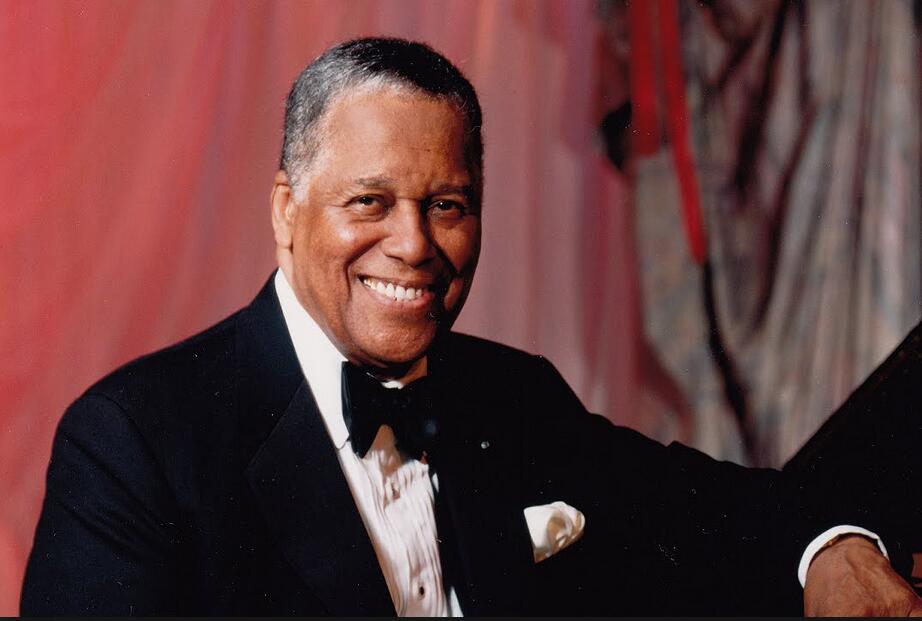(单词翻译:单击)
听力文本
I'm Steve Ember. And I'm Shirley Griffith with the VOA Special English program PEOPLE IN AMERICA. Today, we tell about pianist John Lewis. He created one of one of the most famous jazz groups in America, the Modern Jazz Quartet. John Lewis was known for his creativity. He was a skilled piano player and musical director of the Modern Jazz Quartet for almost fifty years. He wrote and arranged all the music for the small group. Mister Lewis was responsible for the group's sound and its identity. John Lewis was interested in jazz, blues, and bebob, a music with a great deal of energy. Yet he was also greatly influenced by his training in European classical music.
Classical music is expressive and intense, but is also structured. He thought jazz should be presented the same way. John Lewis combined classical music with traditional jazz to create songs for himself and the three other members of his quartet. He believed music should be simple and clear, yet played in a meaningful way. Here is one of the Modern Jazz Quartet's big hits, "Django." John Lewis was greatly influenced by the piano style of the famous jazz bandleader, Count Basie. Like Basie, Lewis believed in making every note of music count. He depended as much on silence as he did on notes to get his message across.
John Lewis often used a form of music called fugue. Fugue is a series of opposing melodies used to create a complex effect. Mister Lewis also combined written music with music that the group invented as it went along. This new kind of jazz attracted both lovers of jazz and classical music. It also appealed to people who did not necessarily like jazz. Here is an example of fugue in the song "Alexander's Fugue."
The Modern Jazz Quartet included John Lewis, Milt Jackson, Percy Heath and Connie Kay. The group made its first recording in nineteen fifty-two. And they continued to play together, with a seven year break, until nineteen ninety-nine. John Lewis was as concerned about appearances as he was about the music. The musicians had to dress well for every performance. They played mostly in concert halls instead of small dance clubs. Lewis believed jazz should receive the same respect as classical music.
John Lewis was born in La Grange, Illinois, in nineteen twenty. He grew up in Albuquerque, New Mexico. He started playing the piano when he was seven. As a teenager, he played professionally in churches around Albuquerque. He soon was playing in local dance halls. Lewis studied anthropology and music at the University of New Mexico. In nineteen forty-two, he joined the Army and served in Europe during World War Two. After the war, Lewis moved to New York City and played in Dizzy Gillespie's big band. He also studied for his master's degree at the Manhattan School of Music. John Lewis played in the rhythm section of Gillespie's band. Other members were drummer Kenny Clarke, bass player Ray Brown and vibraphone player Milt Jackson. The four often performed together while the horn players in the band rested.
The four band members continued to work together after leaving Dizzy's group in the late nineteen forties. At that time, they were criticized for not playing "true jazz." But they continued anyway. Ray Brown and Kenny Clarke soon left the group. Bass player Percy Heath and drummer Connie Kay replaced them. In nineteen fifty-two, the group became the Modern Jazz Quartet and established its own identity. In nineteen fifty-six, the Modern Jazz Quartet played a series of concerts in Europe. The group helped make jazz popular with many music listeners in Europe. The members of the quartet had become major stars by the time they returned to the United States.
The Modern Jazz Quartet continued to perform all over the world for sold-out crowds until the late nineteen seventies. People loved the group's teamwork and their amazing sound. Listen as we play "Vendome", another big hit. Critics say John Lewis's "less is more" piano style and Milt Jackson's energy on the vibraphone were the secret to the group's long-lasting success. Yet over the years, Mister Jackson expressed dissatisfaction with limits that were put on his talents. The group separated in nineteen seventy-four. However, the members of the quartet reunited after seven years. They played together until Milt Jackson's death in nineteen ninety-nine. In addition to his work with the Modern Jazz Quartet, John Lewis worked for many years as musical director of the Monterey Jazz Festival in California.
He wrote the music for several Hollywood films. He taught at Harvard University and the City College of New York. And he helped establish a jazz school in Massachusetts. Through the years, John Lewis worked with some of the biggest names in jazz, including trumpet player Miles Davis. Yet for all the praise Lewis received, he was known for putting the interests of the group over the individual. John Lewis lived a quiet life with his wife, Mirjana, in New York City. In March, two thousand one, he died of cancer. He was eighty years old. His death officially marked the end of a historic period in modern jazz.
重点解析
1.pianist 钢琴家
Howard is a talented pianist.
霍华德是个很有天分的钢琴家。
2.arrange 安排
I've arranged to see him on Friday morning.
我已经安排了星期五早上见他。
3.a great deal of 大量
I also had friends who gave me a great deal of encouragement
我还有些朋友给了我很多鼓励。
4.opposing 反对的;相对的
It is time for opposing factions to unite and work towards a common goal.
现在是对立各派联合起来、为共同目标而奋斗的时候了。
5.appeal to 对…有吸引力
None of these appeal to me.
这些都不能引起我的兴趣。
6.sold-out 卖光的;满座的
The premiere on Monday is sold out.
周一的首映票已经售完。
参考译文
我是史蒂夫·恩贝尔。我是雪莉·格里菲斯。这里是VOA慢速英语栏目《美国人物志》。今天,我们将讲述钢琴家约翰·刘易斯。他成立了美国最著名爵士乐团之一—现代爵士四重奏。约翰·刘易斯以其创造力为出名。他还是一位技巧娴熟的钢琴演奏者,也在现代爵士四重奏乐队担任音乐总监近50年。这个小团队的所有音乐都由他创作安排。刘易斯先生负责这个音乐团队的音调和个性特征。
约翰·刘易斯对爵士乐、蓝调和波普爵士乐(一种充满能量的音乐)很感兴趣。但欧洲古典乐培训的经历也对他有很大影响。虽然古典乐强烈且具表现力,但也很严谨。他认为爵士应该以这样的方式演奏。约翰·刘易斯将古典乐和传统爵士相结合并以此为自己和四重奏中的其他三名成员创作歌曲。他认为音乐应该简单清晰,但弹奏音乐的方式一定要有意义。以下是现代爵士四重奏大受欢迎的作品之一—《Django》。
约翰·刘易斯深受著名爵士乐队领袖康特·贝西钢琴风格的影响。和贝西一样,刘易斯深信一个理念:音乐的每个音符都很重要。就像对待每个音符一样,他也依靠休止符来传递音乐的讯息。约翰·刘易斯经常使用一种被称为赋格曲的音乐形式。赋格曲是利用一系列反旋律来创作一种复杂的效果。刘易斯先生也运用乐队创作的音乐作曲。这种爵士新风格吸引了爵士爱好者和古典音乐爱好者,还吸引了那些并不喜欢爵士的人。以下是歌曲《Alexander's Fugue》中的一段赋格曲。
现代爵士四重奏的成员有约翰·刘易斯、米尔特·杰克逊、珀西·希斯以及康尼·凯。这个乐队首次录制唱片是在1952年。他们继续一同演奏直到1999年,中间有一段7年的间隔期。约翰·刘易斯对外表和音乐一样重视。音乐家们的每一次表演都需要着装得体。他们多数是在音乐厅而非小型舞蹈俱乐部演出。刘易斯认为爵士乐应该受到和古典乐同样的尊重。
约翰·刘易斯于1920年出生于伊利诺斯州拉格兰奇,在新墨西哥州阿尔伯克基长大。他7岁开始弹钢琴。青少年时期,他在阿尔伯克基的教堂专职演奏钢琴。很快,他就在当地舞厅演奏。刘易斯在新墨西哥大学学习人类学和音乐。1942年,他参军了,并在二战期间服役于欧洲战场。战后,刘易斯搬到纽约并在迪兹·吉莱斯皮的大型爵士乐队中演奏。他还在曼哈顿音乐学院攻读硕士学位。约翰·刘易斯在吉莱斯皮乐队的节奏乐器组。其他的成员是鼓手肯尼·克拉克、贝斯手雷·布朗和电颤琴手米尔特·杰克逊。在乐队圆号手休息的时候,他们四个人就经常一起表演。
20世纪40年代末,离开吉莱斯皮乐队后,四人继续共同表演。那时,有人批评他们表演的不是“真正的爵士”。但是他们还是继续这么演奏。很快雷·布朗和肯尼·克拉克离开了团队。贝斯手珀西·希斯和鼓手康尼·凯代替了他们。1952年,团队组成了现代爵士四重奏并建立起了自己的独特风格。1996年,现代爵士四重奏在欧洲举行了一系列音乐会。该乐队帮助爵士在欧洲收获了大批音乐听众。当四重奏的成员们返回美国时,他们变成了大明星。
现代爵士四重奏在全世界演出场场爆满,直到20世纪70年代。人们喜欢这个乐队的合作演奏和他们令人惊异的声音。以下是另一首热门乐曲《Vendome》。评论家认为约翰·刘易斯“少即多”的钢琴风格和米尔特·杰克逊在电颤琴上的能量是这个乐队常青的秘诀。但多年来,杰克逊对乐队限制了他的才能而表示不满。1974年,该乐队解散了。但四重奏的成员们7年后重聚在一起。他们开始共同演奏直到1999年米尔特·杰克逊去世。
除了现代爵士四重奏的工作外,多年来,约翰·刘易斯还担任了加利福尼亚蒙特里爵士音乐节的音乐总监。他为几部好莱坞电影写音乐,还在哈佛大学和纽约市立学院当老师。并且他还帮助在马萨诸塞州成立了一所爵士学院。多年来,约翰·刘易斯和爵士界的一些大人物有合作,比如小号手迈尔斯·戴维斯。虽然刘易斯收获众多褒奖,但他最为人知的是将集体利益置于个人利益之上。约翰·刘易斯和他的妻子米里亚娜在纽约过着安静的生活。2001年3月,他因癌症去世,年80岁。他的离世标志着现代爵士乐中这段历史时期的正式终结。
译文为可可英语翻译,未经授权请勿转载!


